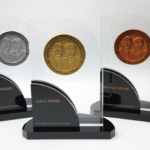Business journalists in the United States earn nearly $30,000 more than their peers and boast widespread salary increases, according to a recent survey conducted by the Donald W. Reynolds National Center for Business Journalism.
The goal of the survey is to gain insight into shifts in the field of business journalism and promote the benefits of a business journalism career to college and high school students.
The median annual base salary for all 244 respondents who reported their salary was $84,615. The median salary for business reporters was $78,260, averaging roughly 12 years of experience in the field. News analysts, reporters and journalists had a median annual salary of $48,370 in May 2021, according to the most recent data from the Bureau of Labor Statistics. The Reynolds Center survey found that respondents who said they were business journalists had a median salary of almost $30,000 more than journalists included in the BLS data — or 62% more.
The median salary for reporters is up by $12,056 from the Reynolds Center’s survey from the previous year — likely due to a majority of respondents indicating that their salaries had increased over the past year. More than 71% of respondents reported that their salary had increased in the past year, whereas 27% said their salary stayed the same.
“While we have only two consecutive years of data in this survey, the data show some encouraging nascent trends. It’s clear that business journalism continues to be an attractive and lucrative career for young journalists in the midst of broader industry turmoil, and diversity in business journalism appears to be improving – albeit slowly,” said Dr. Jeffrey Timmermans, Donald W. Reynolds Endowed Chair Professor of Business Journalism and director of the Reynolds Center.
The Society for Advancing Business Editing and Writing (SABEW) gave essential support to the Reynolds Center’s survey by distributing the survey among its members.
“SABEW is pleased to see that the salaries for business journalists have risen in the past year, as business journalists are integral in explaining what is happening in the economy and the markets and why it is happening,” said Desiree Hanford, SABEW’s president. “SABEW is grateful to the Reynolds Center for its continued excellent work in benchmarking the industry salary and demographic data. The Center’s work is another reminder of how important business journalism is and why mentoring, recruiting and promoting a diverse and inclusive workforce is crucial, as is eliminating pay gaps.”
Pay differences between groups
Similar to the survey last year, there was a strong representation of female-identifying business journalists in the number of respondents (55%). However, despite an overall increase in the median salary for all respondents a gap between male and female respondents appears to still be present.
The data shows that female reporters/correspondents held a median salary that was $12,926 less than their male counterparts ($73,437 and $86,363, respectively) which is a slightly larger gap than the survey showed last year. Similarly, female editors and managers reported a median salary $17,500 less than that of male editors and managers ($102,500 and $120,000, respectively), but that gap is proportionally smaller than the previous year.
A closer look at the data suggests that a portion of this wage gap could be explained by a difference in experience and age from our survey respondents. The average age of female respondents was 8.76 years younger than male respondents who also reported having spent 6.44 fewer years on average as a business journalist than male journalists in the sample.
Accounting for the age and experience of respondents, the wage gap for respondents under 35 almost disappears. However, for journalists 35 and over and for those with at least 10 years of experience as a journalist the wage gap is much more evident – a gap of $7,250 for those over 35 and $7,999 for those with 10+ years of experience.
There was not enough data in the current sample size to accurately compare the median salaries of individual racial groups. However, while there were 47 total non-white respondents, including respondents who selected a multi-racial background, there were only 9 non-white respondents in the survey that selected a supervisory role as their position, indicating the pressing need for increasing diversity in the managerial roles of business journalism.
A promising career for young reporters
Just over a quarter of respondents in our survey (28%) were under the age of 30 and reported a median salary of $64,705. A salary that is in the upper range of entry-level journalism positions, indicating business journalism as a good field for recent graduates to enter.
In addition to higher entry salaries, business journalists reported covering an array of beats that can appeal to a range of journalism graduates. This includes beats spanning traditional business journalism topics like banking, real estate and finance and more specialized coverage areas like retirement investing, the fashion industry, sports business, the cannabis industry, and the social media creator economy.
Not only are younger business journalists more likely to be female than older generations of business reporters, they are also more likely to be from diverse backgrounds. While an overwhelming majority of respondents who provided their race in the overall survey were White — 81.3% – for the journalists who were under the age of 30 (28% of respondents), 64.4% selected White as their sole race/ethnicity. This presents an optimistic outlook for a more representative field of business journalists in the coming years.
About the survey
The Reynolds Center reached out to business journalists throughout the country from small and large publications, including the 42 publications of the American City Business Journals, and collaborated with SABEW to invite their 2500+ members to participate between April 20 and May 5, 2023.
A total of 254 journalists from 35 states responded to the survey, with 42.5% of respondents reporting from New York, California, Washington D.C., Texas, and Florida. The average age of respondents was 40.61 with an average of 16.3 years of experience as a journalist. The majority of survey respondents’ reported White (81.3%) as their race/ethnicity with 5.6% Asian, 4.8% multiracial, 4% Black, and 3.2% Latinx/Hispanic.
Nearly 89% of respondents stated they work in print or digital media outlets, with a very sparse distribution of business journalists in other mediums like television or radio. For those working in print/digital outlets, the distribution was almost evenly split between the 42 Business Journals (24.9%), regional/local publications (31.6%) and global/national publications (30.7%), with a small percentage of respondents stating they work for a magazine or other type of publication.
The Reynolds Center for Business Journalism was established in 2003 with the goal of improving the quality of media coverage of business and the economy. The Reynolds Center is housed inside the Walter Cronkite School of Journalism and Mass Communication at Arizona State University.
For more information about the Reynolds Center’s salary survey, contact: reynoldscenter@gmail.com.











